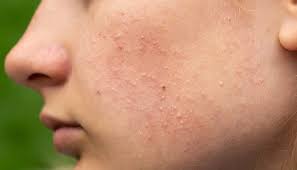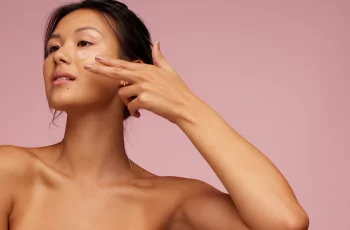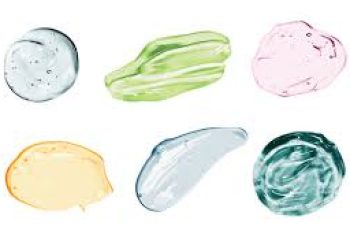Fungal Acne: Could This Be Causing Your Persistent Pimples?
If you’ve tried what seems like everything to get rid of persistent acne that won’t go away, no matter which treatments or skin care you use, it is possible that you might not be dealing with acne at all, but a condition caused by a yeast overgrowth known as fungal acne. This condition, scientifically known as Malassezia folliculitis or Pityrosporum folliculitis, is characterized by a fungal infection of hair follicles, which can look a lot like acne on the surface.
Here, I’ll explain more about what fungal acne is and how it is different from other true types of acne and what you can do to finally get rid of it.
Fungal acne is caused by an overgrowth of Malassezia yeast.
Tight-fitting clothing, hormonal imbalances, medications, and diet can affect fungal acne.
Fungal acne needs to be treated with antifungal ingredients. Treatments for acne vulgaris won’t work for this condition.
What Is Fungal Acne?
Fungal acne is an inflammatory skin condition that happens when an overgrowth of a specific type of yeast called Malassezia causes a fungal infection inside the hair follicles, or pores, in your skin. This causes red, inflamed pustules or papules that resemble acne, as well as itching. Because it so closely resembles acne vulgaris, however, fungal acne is often misdiagnosed and incorrectly treated, making it a persistent, frustrating problem.
Fungal Acne Causes
Fungal acne occurs when there’s an imbalance in your skin’s natural microbiome, allowing Malassezia yeast to multiply. There are several triggers that can contribute to this overgrowth:
Excessive sweating. Working out or being in humid environments can create a warm, moist environment where yeast thrives. This is made worse when you wear tight, non-breathable fabrics that trap moisture and allow yeast to thrive.
Hormonal imbalances. Some hormone-related conditions like PCOS (polycystic ovary syndrome) or insulin-resistance may make you more susceptible to fungal acne (3).
Medications. Antibiotics used to treat bacterial acne can sometimes disrupt the skin’s microbiome, promoting yeast growth.
Diet. Yeast thrives in a high-sugar environment, so eating lots of sugary foods or simple carbohydrates can contribute to fungal acne.
Certain skin care ingredients. Some oils, fatty acids, esters, and polysorbates in skin care can help yeast thrive on the skin.
Climate. Yeast thrive in warm humid environments so this is more common in the summer in humid climates.
What Does Fungal Acne Look Like?
Fungal acne usually appears as small, uniform pustules or papules that are often itchy and tend to form in clusters. These bumps tend to show up on areas that are prone to sweating, like the forehead, chest, back, and upper arms, although they can show up anywhere on the face or body. They may look like tiny pimples, but they don’t have blackheads or whiteheads. The skin can feel irritated or itchy, and the breakouts may worsen in hot, humid conditions.
Fungal Acne vs. Acne Vulgaris
While fungal acne is caused by yeast overgrowth, acne vulgaris (the typical type of acne that most people are familiar with) is caused by a bacterial overgrowth. These two conditions can look similar and can be tricky to tell apart, but there are a few key differences.
One of the most important distinctions is that fungal acne, unlike acne vulgaris, typically does not involve comedones (clogged pores like blackheads or whiteheads). Instead, fungal acne typically shows up as a uniform cluster of red, itchy bumps. Acne vulgaris, on the other hand, often includes a mix of comedones, cysts, and pustules.
Fungal Acne vs. Hormonal Acne
Hormonal acne tends to occur deeper in the skin, forming painful cysts that often pop up in the same areas each month, especially around the chin and jawline. In contrast, fungal acne is more superficial and usually feels itchy. While hormonal acne is driven by fluctuations in hormones like estrogen and testosterone, fungal acne is triggered by an overgrowth of yeast.
How Is Fungal Acne Treated?
Typical treatments for regular acne will not work for fungal acne, which is why this condition can be so frustrating if it is misdiagnosed. Fungal acne is treated in the same way as other conditions involving yeast overgrowth, such as tinea versicolor. The most effective treatments include:
Antifungal shampoos. Shampoos that contain antifungal ingredients like ketoconazole, selenium sulfide, or zinc pyrithione can be used on the scalp or body to kill the yeast.
Antifungal creams. Topical antifungal medications like clotrimazole or terbinafine can also be applied to the affected areas to get rid of the yeast.
Sulfur. Washes like Derma Made Medi Wash that contain sulfur – which has antimicrobial and antifungal properties – can help to reduce the amount of yeast on the skin that is causing fungal acne.
Oral antifungal medications. In more severe cases, your dermatologist might prescribe an oral antifungal medication like fluconazole to treat fungal acne that doesn’t respond to other treatments.
Derma Made Medi Wash contains both sulfur and salicylic acid to help reduce inflammation and redness, keep pores clean, and kill yeast overgrowth on the skin.
This wash can also be effective for reducing redness caused by rosacea and other inflammatory conditions. It is suitable for most Baumann Skin Types (Types 1–12).
Can Fungal Acne Be Prevented?
There are steps you can take to keep fungal acne at bay once you’ve successfully treated it using the methods listed above.
Shower and immediately change out of workout clothes after sweating in them.
Use a dandruff shampoo or sulfur-containing wash to kill yeast and keep the population from overgrowing on your skin.
Talk to your doctor about any hormonal concerns such as PCOS that may be linked with an increase in susceptibility to recurring yeast infections.
Bottom Line
If you’ve been battling persistent breakouts that don’t respond to regular acne treatments, you might be dealing with fungal acne. This skin condition is caused by yeast overgrowth and can be treated with antifungal products like sulfur washes and medicated shampoos. If you are unsure about whether your breakouts are caused by true acne or a fungal infection, see your dermatologist for an accurate diagnosis so you know you are using the correct treatments for your skin condition and type.
DQH Knowledge drop: In your 20s, your skin cell turnover decreases. (Cell turnover is a key component in keeping your skin youthful.) You know what else slows down? Your collagen production. Starting in your 20s, collagen decreases by about 1 percent per year. Should you want to prevent fine lines and wrinkles, start by eliminating behaviors that contribute to premature aging. “If it’s bad for you, it’s bad for your skin,” says dermatologist Michel Somenek.
“Cigarette smoking reduces blood flow to the skin and causes premature wrinkling and a dull skin texture. Making the repeated pursed motion to inhale can also cause smoker’s lines. Alcohol and recreational drugs are toxins for the skin that damage its cellular structure and DNA,” Somenek tells us. “The faster you eliminate vices while you are young, the better chance your skin and body have to recuperate.” Also, adopting an anti-aging routine in your 20s is key. After all, the best offense is a good defense. We spoke to Somenek and experts Joshua Ross and Audrey Kunin to find out more.
Keep reading for the best anti-aging products for your 20s, according to skincare professionals.
Sunscreen
“We all know that the sun is the number one cause of skin aging and starting the prevention in your 20s is very important,” Ross says. “The majority of your sun damage won’t start to appear until you’re in your 30s, so don’t wait until you see it surface or you’ll be behind the curve. Stay ahead of it with a good-quality zinc-based sunscreen worn daily.”
Farmacy Green Defense Daily Mineral Sunscreen
An invisible sunscreen with SPF 30, plus botanical extracts meant to protect skin with tons of antioxidants. Bonus: It’s clean and fine to use under makeup.
Bareminerals Complexion Rescue™ Tinted Moisturizer Broad Spectrum SPF 30
Although we recommend you use your SPF and moisturizer separately, we also understand moments when you don’t have time or energy for that extra step. For those times, this bareMinerals moisturizer is a great thing to have on hand.
Vitamin C Serum
“A great introduction to anti-aging is to start with a vitamin C serum in your morning skincare routine,” Ross says. “It’s a powerful antioxidant that will neutralize free radicals and brighten the skin.” He adds that it’s a great way to counteract the effects of the sun’s harmful rays, which, as previously mentioned, are among the biggest causes of premature aging.
Drunk Elephant C-Firma™ Vitamin C Day Serum
The Drunk Elephant C-Firma is a lightweight serum that promises to give skin a glow by combining the brightening powers of vitamin C with ferulic acid, l-ascorbic acid, and vitamin E. The included sodium hyaluronate is meant to replace hydration loss, so you shouldn’t have to deal with any irritation.
Sunday Riley C.E.O. Rapid Flash Brightening Serum
This potent serum is jam-packed with vitamin C (15 percent, to be exact), which means it’s a potential superstar at both brightening skin and dousing it in antioxidants.
Peptides
Using peptides on your skin has many benefits, says Somenek. “The skin barrier is what defends the body against pollution, UV rays, bacteria, and toxins. It can be damaged by several everyday factors. Using topical peptides aids in building a stronger barrier,” he says. “Peptides comprise elastic fibers, which are a type of protein. These fibers help to make skin appear taut and firm. Peptides can also help repair damaged skin, relieve inflammation, and even out skin tone. Some peptides can kill acne-causing bacteria that is common in 20-somethings.”
Kunin agrees, saying, “Peptides are an excellent entry point for supporting collagen.” She recommends looking for face and eye treatments that contain these collagen-boosting powerhouses.
Charlotte Tilbury Magic Eye Rescue Cream
This Charlotte Tilbury super-emollient eye cream has a base of coconut oil and shea butter (read: it’s incredibly hydrating). Botanicals plus peptides are meant to help reduce dark circles and boost collagen, respectively.
This creamy moisturizer serves up potent collagen-boosting peptides and pycnogenol, and antioxidant-rich vitamin C. “Instead of sitting on top of the skin, peptides penetrate the outer layer so they go deep. The ‘signals’ they send tell the cells to produce elastin and collagen, which are needed for youthful-looking skin,” explains Somenek.
At-Home Peel Pads
Remember that skin cell turnover fiasco we talked about earlier? One way to help support it is by exfoliating. “Exfoliation is important to help keep skin fresh and luminous,” Kunin says. She recommends using at-home peel pads as an easy and effective way to exfoliate.
“The goal in your 20s is to fight the slowing pace of cell turnover. It is wise to use products that gently exfoliate, yet still remove oil and other impurities. Products that have Alpha Hydroxy Acids (AHA) or Beta Hydroxy Acids (BHA) are a good choice.”
According to Somenek, you should only exfoliate two to three times a week. “People of all ages are guilty of over-exfoliating and that can be too much of a good thing,” he says.
Dermadoctor Kakadu C Intensive Vitamin C Peel Pad
A few swipes of this Derma Doctor powerful peel pad promise to leave your skin glowing and smooth, thanks to the seven (yes, seven) types of chemical exfoliants, including AHA and BHA. It also contains vitamin C via Kakadu plum extract for added brightening and antioxidant protection.
KEY INGREDIENTS Kakadu plum extract is sourced from the Kakadu plum, a fruit grown in northern Australia. It contains vitamin C, which restores the skin’s natural barrier, increases collagen production, and soothes irritation.
Dr. Dennis Gross Skincare Alpha Beta® Universal Daily Peel Pads
These are the gold standard of peel pads, with a cult following and over 900 five-star reviews on Sephora. They’re easy to use and contain a blend of anti-aging exfoliating acids.
Emollient Night Cream
“In your 20s, you need to start upping the hydration in your skincare routine. You may have been cautious of over-moisturizing because of acne in your teens, but as you enter your 20s, your skin transitions and becomes drier,” Ross says. “I recommend an emollient night cream added into your evening skincare regimen.”
“Twenty-somethings need to make sure that they are not using creams that will clog their pores and cause excess oil production,” says Somenek. Opt for non-comedogenic products.
Cerave Skin Renewing Night Cream
One great choice is the CeraVe Skin Renewing Night Cream, which is a non-comedogenic night cream that leaves skin soft and glowy. It combines the moisturizing powers of ceramides and hyaluronic acid.
RoC Retinol Correxion Max Hydration Creme
“The best night cream ingredients contain retinol, benzoyl peroxide, and/or salicylic acid or hyaluronic acid. The goal is to moisturize, yet remove excess oil,” says Somenek. This Roc Retinol Correxion cream fits the bill as it contains both hyaluronic acid and retinol so it promises to moisturize while also being non-comedogenic.



